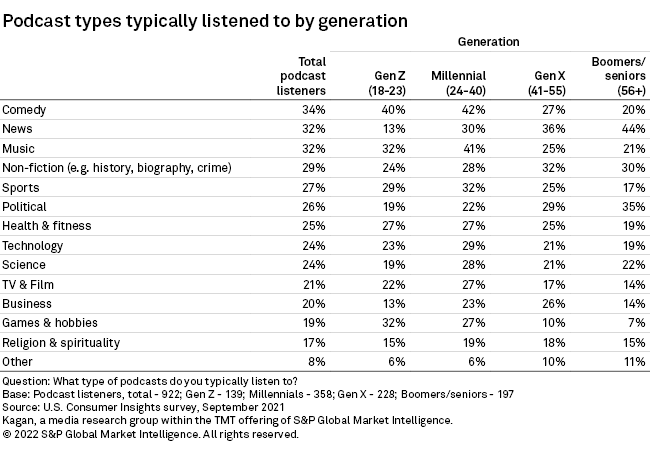Featured Topics
Featured Products
Events
S&P Global Offerings
Featured Topics
Featured Products
Events
S&P Global Offerings
Featured Topics
Featured Products
Events
S&P Global Offerings
Featured Topics
Featured Products
Events
Financial and Market intelligence
Fundamental & Alternative Datasets
Government & Defense
Banking & Capital Markets
Economy & Finance
Energy Transition & Sustainability
Technology & Innovation
Podcasts & Newsletters
Financial and Market intelligence
Fundamental & Alternative Datasets
Government & Defense
Banking & Capital Markets
Economy & Finance
Energy Transition & Sustainability
Technology & Innovation
Podcasts & Newsletters
Research — 8 Mar, 2022

By Brian Bacon
Introduction
While the total podcast listening audience may still be relatively small, those who do tune in to podcasts tend to listen frequently. According to data from Kagan's U.S. online consumer survey conducted in September 2021, just over one-third (36%) of respondents indicated they listen to podcasts. However, most of those listeners (25%) listen at least once per week.

* Even among older podcast listeners, over half listen at least once per week.
* News podcasts were more popular among older podcast listeners, capturing the largest share among baby boomers/seniors at 44%.
* Frequent podcast listeners use more subscription video on demand and ad-based video on demand services compared to infrequent listeners.


Over half of podcast listeners are tuning in at least once per week, even among boomers/seniors at 56%. However, Gen Z and millennial podcast listeners were much more likely than older generations to indicate they listen daily, at 32% and 31%, respectively, or several times per week, at 32% and 35%, respectively.

Since younger listeners were more likely to indicate they listen frequently, it might be expected that they were also more likely to listen to news or political content, which tend to air more frequently than other genres, but this is not the case. Instead, younger podcast listeners were more likely to indicate they preferred other genres surveyed, including sports, comedy, music, TV and film, and games and hobbies. Business podcasts were most popular among millennial and Gen X podcast listeners at 23% and 26%, respectively. The health and fitness, science and nonfiction genres were fairly evenly split across generations. The age divide was most noticeable for news, listened to by just 13% of Gen Z podcast listeners versus 44% of boomers/seniors.

Podcast listeners were more likely than nonlisteners to use SVOD services at 95% and 76%, respectively. Frequent listeners had the highest average number of SVOD services used at 5.9, compared to 3.9 for infrequent podcast listeners and 2.5 for those who don't listen to podcasts. While Netflix Inc. and Amazon.com Inc.'s Prime Video were used by about an equal share of frequent and infrequent podcast listeners, frequent listeners were more likely to use each of the other services surveyed.

A similar situation existed for the use of AVOD services, with podcast listeners more likely to use these services compared to those who do not listen to podcasts. Frequent podcast listeners used an average of 4.8 AVOD services, about one more than infrequent podcast listeners at 3.7 AVOD services. Frequent podcast listeners were more likely to use most of the AVOD services surveyed than infrequent listeners. Interestingly, infrequent podcast listeners were more likely to indicate they use Alphabet Inc.'s YouTube, at 71%, compared to 59% of frequent podcast listeners.

Data presented in this article is from Kagan's U.S. Consumer Insights survey conducted in September 2021. The online survey included 2,529 U.S. internet adults matched by age and gender to the U.S. Census. The survey results have a margin of error of +/-1.9 ppts at the 95% confidence level. Percentages are rounded up to the nearest whole number. Gen Z adults are individuals ages 18-23. Millennials are ages 24-40; Gen Xers are 41-55 years old; and baby boomers/seniors are 56 and older.
Consumer Insights is a regular feature from Kagan, a media research group within the TMT offering of S&P Global Market Intelligence.
This article was published by S&P Global Market Intelligence and not by S&P Global Ratings, which is a separately managed division of S&P Global.